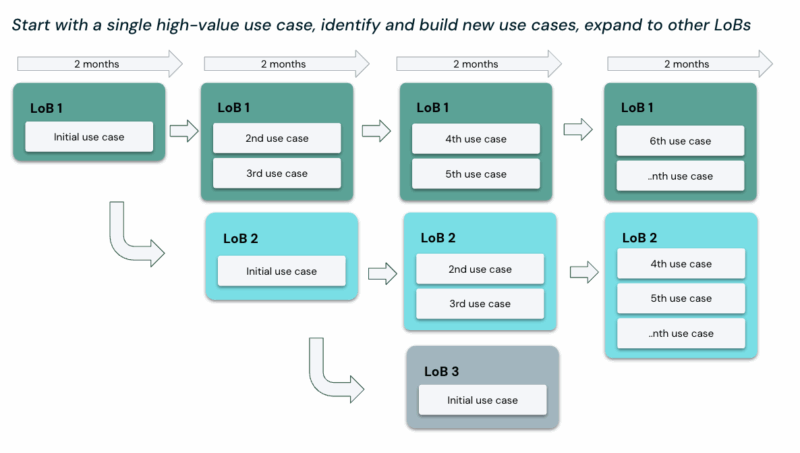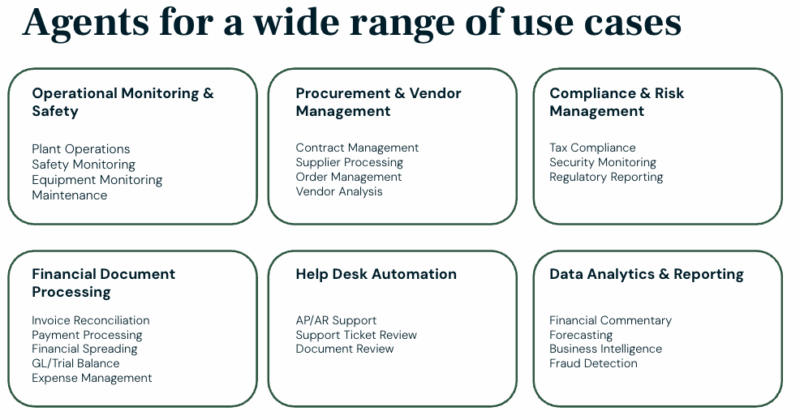Reflections on the rapid evolution of enterprise AI adoption and what it means for the future of work
Three months ago, I started closely observing the enterprise AI agent landscape. What I’ve witnessed has fundamentally shifted my perspective from cautious skepticism to genuine conviction: we’re not debating if AI agents will transform enterprise work, but when mass adoption will unlock their full potential.
I recently attended an innovation focused conference in Las Vegas where we had some great conversations with enterprises looking to adopt AI agents. One conversation was with a large automotive manufacturer that is now setting up a center of excellence for AI and agents to help drive and coordinate the strategy across the company. We discussed a range of topics from how and where leading organizations are starting their agentic journey to what is the makeup of successful teams when deploying agents.
Based on that conversation and many others here’s what I’m seeing in the trenches.
Enterprise interest is real—and growing fast
The enterprise appetite for AI agents isn’t hype—it’s hunger. Organizations across industries are actively exploring how AI agents can transform their operations, driven by competitive pressure and the promise of unprecedented efficiency gains. This isn’t the usual “wait and see” enterprise approach; leaders are moving with urgency because they recognize the strategic advantage at stake.
The starting line dilemma
Interestingly, many enterprises are struggling with where to begin. Some are gravitating toward complex, high-value workloads—the kind that promise massive ROI but come with equally massive implementation challenges. It’s a classic enterprise pattern: go big or go home. While ambitious, this approach sometimes creates unnecessary barriers to getting started and seeing early wins.
The pipeline effect: one use case becomes dozens
What’s fascinating is that while enterprises often start with a single high-value use case, the discovery process quickly reveals a much larger opportunity landscape. I’m consistently seeing organizations identify dozens of potential use cases across multiple business units once they begin seriously evaluating AI agents.
It starts with finance automating invoice processing, but quickly expands to HR handling employee onboarding, procurement managing vendor communications, legal reviewing contracts, and operations optimizing supply chain workflows. The pattern is remarkably consistent: one successful pilot becomes a catalyst for enterprise-wide transformation thinking.

This pipeline effect is both exciting and challenging. Exciting because it demonstrates the broad applicability of AI agents across business functions. Challenging because it can overwhelm organizations that aren’t prepared to manage multiple concurrent initiatives or prioritize effectively across competing demands.
The smartest enterprises I’m observing are building systematic approaches to use case identification and prioritization, creating centers of excellence that can support multiple business units while maintaining consistency in implementation approaches and governance standards.
Innovation at every layer is unlocking stuck use cases
The pace of innovation across the entire AI stack is breathtaking. From breakthrough reasoning models like GPT-5 and Claude Sonnet 4 to advances in document understanding and multi-modal capabilities, technical limitations that blocked use cases just months ago are rapidly disappearing. What seemed impossible in Q1 is becoming routine in Q4.
This isn’t just about LLMs getting smarter—it’s about the entire ecosystem of tools, frameworks, and platforms evolving to make AI agents more accurate, reliable, and enterprise-ready.

Production deployments across diverse workloads
AI agents are moving beyond pilots into real production environments, handling everything from document-intensive processes to complex data analysis workflows. I’m seeing successful deployments that combine both approaches—agents that can understand unstructured documents while simultaneously analyzing structured data to make informed decisions.
The variety is striking: invoice processing, contract analysis, customer service automation, financial reconciliation, and regulatory compliance workflows. Each represents real work being transformed by intelligent automation.
Implementation reality check
Not everything is moving at Silicon Valley speed. Some implementations are taking longer than initially expected, particularly when they require significant organizational change or integration with legacy systems. But here’s the key insight: they’re still moving forward. The delays aren’t causing abandonment—they’re driving more thoughtful, sustainable approaches to AI adoption.
The vendor innovation layer
While everyone focuses on LLM advances, there’s equally impressive innovation happening at the platform layer—where companies like Sema4.ai operate. We’re seeing rapid development of tools that make AI agents more accessible to business users, more secure for enterprise deployment, and more capable of handling complex, real-world scenarios.
This vendor innovation is crucial because it bridges the gap between raw AI capability and practical business application.
Agents that learn and adapt
One of the most exciting developments is watching AI agents exceed their original design parameters. Agents built for specific tasks are demonstrating the ability to learn, reason, and handle scenarios they weren’t explicitly programmed for. This adaptability is what separates true AI agents from traditional automation—they’re not just following scripts, they’re thinking through problems.
Real value in production
When AI agents make it to production, the results are compelling: significant cost reductions and substantial efficiency gains. I’m seeing organizations report 60-80% time savings on document processing workflows, 90% reduction in manual data entry errors, and the ability to handle 10x more volume with the same team size.
These aren’t theoretical benefits—they’re measurable business outcomes that justify continued investment and expansion.
Data analytics: promises and pitfalls
Some of the most interesting use cases are emerging around data analytics, where AI agents can democratize complex analysis for business users. However, these implementations often surface data quality issues that need resolution—sometimes within the agent’s capabilities, sometimes requiring upstream fixes.
This highlights an important principle: AI agents can be incredibly powerful, but they’re not magic. Good data practices still matter.
Separating signal from noise
There’s still significant confusion in the market about what’s real versus what’s marketing. The hype cycle is in full swing, making it challenging for enterprises to separate genuine capability from aspirational positioning. This confusion is natural but temporary—real-world results will ultimately separate the wheat from the chaff.
Rethinking the MIT study
The widely cited MIT study suggesting 95% failure rates for AI implementations feels disconnected from what I’m observing. While there are certainly challenges—particularly around the organizational changes needed to integrate “digital workers”—the failure narrative doesn’t match the reality of persistent enterprise investment and growing production deployments.
The real challenge isn’t technical failure; it’s organizational adaptation. Companies need to rethink workflows, redefine roles, and establish new governance frameworks. This takes time and intentional change management, but it’s happening. Here is a good analysis of the study.
The tide is turning
After 90 days of close observation, I’m convinced we’re approaching an inflection point. The combination of improving technology, growing enterprise confidence, successful production deployments, and vendor innovation is creating conditions for mass adoption.
The skeptic in me has been replaced by a believer—not in the hype, but in the fundamental transformation that’s underway. Enterprise AI agents aren’t just the next productivity tool; they’re the foundation for reimagining how work gets done.
The question isn’t whether this transformation will happen. The question is whether your organization will lead it or follow it.
Contact us if you would like to learn more about how successful organizations are defining and implementing their agentic strategies.
What are you seeing in your organization’s AI journey? The landscape is evolving rapidly, and every perspective adds valuable insight to our collective understanding of this transformation.


